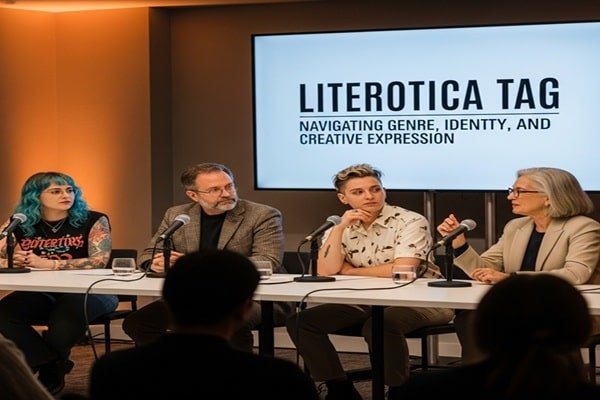
In the vast world of online storytelling, where every fantasy, feeling, and forbidden thought finds a voice, literotica tags play a surprisingly powerful role. They’re more than just keywords—they’re cultural markers, navigational tools, and even ethical guides that shape how readers and writers connect in the realm of adult-themed literature.
Whether you’re a curious reader exploring new genres or a writer looking to reach the right audience, understanding how literotica tags work can completely transform your experience. Let’s break it all down in a way that’s simple, engaging, and maybe even eye-opening.
What Exactly Is Literotica?
The term literotica merges “literature” and “erotica,” describing written works that explore sensuality through imagination and storytelling rather than just explicit imagery. Unlike visual adult content, literotica dives into:
-
Emotional intimacy
-
Character development
-
The psychology of desire
-
Storylines that mix sensuality with heart
It’s not just about what happens—it’s about how it feels. And this is where tags become essential.
The Power of Literotica Tags
At their core, literotica tags are descriptive keywords that classify stories by theme, genre, tone, or dynamic. They help both writers and readers navigate the huge sea of online content.
Think of them as the GPS of the literary erotica world—guiding you exactly where you want (or don’t want) to go.
A tag might describe:
-
Themes like “forbidden love,” “revenge,” or “redemption”
-
Genres such as “fantasy,” “BDSM,” or “sci-fi erotica”
-
Tone like “dark,” “humorous,” or “slow burn”
-
Dynamics such as “dominant/submissive” or “switch”
-
Character roles like “professor/student” or “step-sibling”
When used right, these tags tell readers what kind of emotional or sensual journey to expect.
Why Classification Matters
With thousands of new stories appearing daily across platforms, categorization is crucial. Without tags, readers could easily stumble onto something uncomfortable—or miss out on what they actually want to read.
Tags make it easy to:
Discover your favorite genres and authors
Avoid content you’re not comfortable with
Find stories that match your mood or curiosity
Explore new niches safely
In short, literotica tags are not just helpful—they’re respectful.
The Main Types of Literotica Tags
Let’s look at the most common types you’ll see—and what they tell you.
1. Content-Based Tags
These explain what happens in the story. Examples include:
-
First-time experience
-
Age gap
-
Voyeurism
-
Group play
-
Role reversal
They set the stage for key story elements and guide reader expectations.
2. Genre or Sub-Genre Tags
These define the world of the story:
-
Historical romance
-
Paranormal fantasy
-
Erotic horror
-
Contemporary drama
Genre tags help you find stories that match your aesthetic or vibe.
3. Tone and Style Tags
Tone shapes the emotional flavor of a story. Examples:
-
Playful
-
Dark
-
Poetic
-
Satirical
-
Melancholic
Want something steamy but tender? Or gritty and raw? Tone tags will show you.
4. Relationship Dynamic Tags
These describe the emotional and power balance between characters:
-
Gentle dom
-
Alpha female
-
Submissive partner
-
Power exchange
-
Polyamorous
For many readers, dynamic tags are the heart of their search—they define what kind of connection drives the story.
The Ethics of Tagging: Consent and Clarity
Tagging responsibly isn’t just about marketing—it’s about ethics.
Proper tags allow readers to make informed choices and avoid potentially triggering or distressing material. Responsible tagging supports consent culture and builds trust between writer and reader.
Writers often use tags for:
-
Trigger warnings (non-consent, age difference, abuse themes)
-
Sensitivity markers (drug use, mental health, violence)
-
Clarity on tone or realism
Platforms usually have moderation policies, ensuring tags aren’t used misleadingly. Misusing or omitting critical tags can harm reputations and even lead to content bans.
Also Read : F95: Understanding the Platform, Its Content, and the Culture Behind It
How Writers Use Tags Strategically
Good writers know tagging is an art form. It’s how you attract the right readers—not just more readers.
For instance:
-
A story tagged “forbidden attraction” + “slow burn” + “emotional degradation” will appeal to an introspective audience.
-
Meanwhile, “public play” + “humor” + “consensual kink” attracts those looking for something fun and cheeky.
Writers use tags to:
-
Boost visibility in searches
-
Connect with niche communities
-
Set expectations for tone and intensity
-
Build long-term reader trust
Smart authors practice tag stacking—using several accurate tags without overdoing it. Over-tagging confuses readers, while under-tagging limits reach.
Community Dynamics and Reader Trust
In the literotica community, trust is everything. Readers rely on tags to know what they’re stepping into. When a story breaks that trust—say, promising “romance” but delivering something dark or non-consensual—it can lead to backlash.
Tags create an unspoken agreement:
“I’ll tell you what you’re about to read, and you can decide if it’s for you.”
Popular tag trends often reflect social shifts, too. A few years ago, “office romance” and “forbidden professor” were hot. Today, “healing through intimacy” or “ethical non-monogamy” are on the rise—showing how culture and values evolve.
Literary Craft Within Literotica
The best literotica isn’t just erotic—it’s literary. Writers often blend sensual storytelling with emotional arcs, tagging stories for depth and context.
Examples:
-
“Reconciliation” — signals emotional healing
-
“Revenge” — adds tension and conflict
-
“Aftercare” — promises empathy after intensity
Some stories are character-driven (focusing on inner transformation), while others are plot-driven (built around a thrilling situation). Tags help readers choose between the two styles effortlessly.
Tagging Across Platforms
Tag systems vary depending on where stories are published:
-
AO3 (Archive of Our Own) allows user-generated tags—anything goes, creating a rich but chaotic ecosystem.
-
Commercial platforms often limit tags for consistency.
-
Private sites or subscription platforms might use exclusive tags to serve niche audiences.
Interestingly, different communities develop their own tag dialects. What’s called “dom/sub” on one site might be “power exchange” on another—same dynamic, different language.
Literotica Tags in a Cultural Context
Tags aren’t just functional—they’re historical snapshots of changing social norms.
In the 1990s, “interracial romance” or “taboo attraction” were considered edgy. Today, they’re normalized, while new discussions around consent, identity, and power dynamics dominate tagging trends.
Some communities even use tag activism—embracing labels that promote diversity, mental health awareness, or body positivity.
For example:
-
Queer identity tags celebrate representation.
-
Kink-positive tags encourage safe, informed exploration.
-
Healing-themed tags bring emotional nuance to erotic writing.
The Bottom Line
A literotica tag isn’t just a label—it’s a promise. It guides discovery, protects consent, and fosters creativity. Tags turn chaos into connection, helping both writers and readers find what they’re truly looking for in the vast, intimate world of online storytelling.
By tagging thoughtfully, writers honor their readers’ boundaries while inviting them into an experience built on trust, emotion, and imagination.
So the next time you scroll through a story list, take a closer look at those tags—they’re doing far more than you think.
FAQs
1. What is a literotica tag used for?
It helps categorize stories by theme, genre, or tone, making them easier to find and explore.
2. Why are tags important in adult literature?
They help readers make informed choices, promoting consent and clarity.
3. Can a story have multiple tags?
Absolutely. Most stories include several tags to reflect all major elements accurately.
4. Are tags the same on every platform?
Not quite—each site has its own tagging culture and rules.
5. What ethical rules apply to tagging?
Always be honest and transparent. Misleading tags can break reader trust.
6. Can readers search by tags?
Yes! Tags often act like filters, helping readers navigate specific interests easily.

